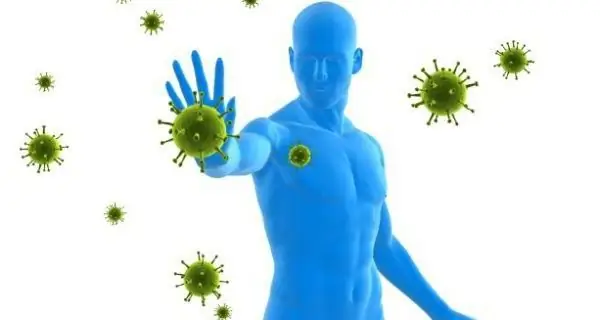- Author Curtis Blomfield [email protected].
- Public 2023-12-16 20:44.
- Last modified 2025-01-23 17:01.
For most Russians, the idea of immunity is formed under the influence of commercials. Means for maintaining and strengthening it are offered in the form of yogurts, curds, vitamins, using which you can completely forget about all the sores. In fact, the state of the immune system depends not only on the intake of a fermented milk product or a biological supplement. Moreover, with the abundance of all widely advertised means to strengthen the immune system, especially medicinal ones, such as immunomodulators and immunostimulants, their use must be approached with extreme caution. Often rants about miracle products are just a clever publicity stunt.
The concept of immunity

Immunity is a mechanism of action of immune cells aimed at maintaining the constancy of the internal environment of the body, formed in order to protect against infections and viruses and develop methods to resist the effects of the latter when they penetrate.
Types of immunity
Types of immunity have many classifications according tovarious signs.
First of all, they share innate and acquired types of immunity.
Congenital type due to heredity, transmitted through the placenta with mother's blood, breastfeeding with milk.
Acquired immunity is formed throughout a person's life. Influencing factors are the environment with its bacteria, past infections. This type suggests a division into active immunity, which is modulated by remembering the pathogen of the disease by immune cells, and passive, when ready-made antibodies are introduced into the body using vaccines and sera.
Local immunity is divided into general and local. The general immune system covers the entire body with protection, the local one - a specific organ.
According to the action, humoral and cellular immunity are distinguished.
Anti-infectious, antitumor and transplant immunity are distinguished by directions.
Antitoxic immunity is one of the types of anti-infective immunity.
Antitoxic type of immune response
Antitoxic immunity is aimed at neutralizing toxic substances released by pathogens of such diseases as diphtheria, tetanus, gas gangrene, botulism, poliomyelitis, dysentery. Its protective properties are based on the action of immunoglobulin G. It is he who builds protection against the toxic effects of harmful microorganisms, producing specific antibodies for each. Immunoglobulin G also has a memory, and if the body has been repeatedly intoxicated with the samevirus, it will remove it quickly enough.
Method of action and features of antitoxins
Antitoxic immunity is due to the action of antitoxins, which are produced in response to the toxic effect of toxins released by microorganisms that carry the infection, inhibiting the activity of their toxic properties.
German scientist P. Ehrlich developed a scheme that displays the principle of action of antitoxins on toxins. The toxic effect of a toxin occurs when it has managed to cling to a living substance in the blood. If such a connection occurs, the living element of the blood is exposed to the poisonous influence of the toxin.

The links of a living element with an attached alien toxin act in the body far from this direction, so the immune system begins to replace the connecting parts occupied by toxins with new ones. These new links are antitoxins. In adhesion with the toxin, they suppress the effect of the latter on living matter.

From here the main feature of antitoxic immunity was derived: antibodies (antitoxins) do not kill the antigen, but neutralize its toxic properties. Ehrlich's research gave a new characteristic to the types of immunity. It began to be divided into cellular (earlier discovered by I. Mechnikov) and humoral, which is formed in blood plasma.
The use of antitoxins in medicine
The antibodies produced by the body itself are not always enough to suppress the toxic effects of antigens. German immunologist-microbiologist A. Behring andthe Frenchman E. Roux, based on Ehrlich's research, invented an antitoxic serum. In the early stages of a disease such as diphtheria, antibodies to diphtheria toxin are injected into the patient, and with their help, the patient successfully copes with the disease.
In general terms, diphtheria serum is a liquid containing a large number of antitoxins. It is obtained with the participation of horses resistant to diphtheria. The diphtheria antigen is injected into the animal until the animal begins to produce a huge amount of antibodies to it. Such blood serum with a high concentration of antibodies to diphtheria is a powerful weapon against this poisonous infection.

The same method of treatment is used for other infectious diseases, such as tetanus, dysentery, etc. Patients are given a serum with a high content of antitoxins to poisonous antigens of the disease.
Mechanisms for producing an antitoxic immune response
This form of immune response is not hereditary, capable of being passed from mother to fetus. Antitoxic immunity - acquired, produced by the introduction of toxic antigens in a natural or artificial way. Naturally, antitoxic protection is acquired during the transfer of highly toxic infectious diseases, when the self-production of antitoxins by the body is a response to the toxic effects of pathogens.
Artificially antitoxic immunity is produced by the introduction of vaccines or toxoid, andalso immune sera.

Immune tension
The risk of an organism being affected by an infectious disease depends on the amount of antibodies produced in the liquid part of the blood against this disease. The body's resistance to pathogens is called immunity tension.
The level of resistance is analyzed separately for each disease and is determined by the amount of antitoxins produced. For example, if 1/30 of 1 ml of blood is an antitoxin against diphtheria, then we can confidently say that there is no risk of infection.
In conclusion, it should be noted that immunology gives its place of honor to antitoxic immunity, since the study of its mechanisms of action and production made it possible to rid mankind of such deadly diseases as diphtheria, tetanus, dysentery, botulism, gas gangrene, etc.






